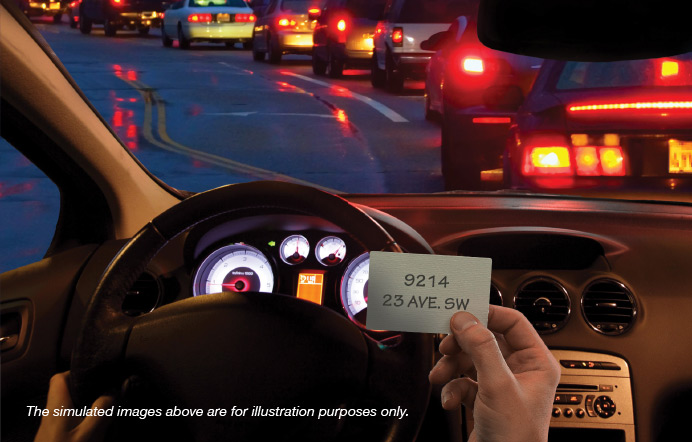Knowing your options
There are many lenses to choose from for your surgery. It’s important to know what each type of lens can offer you, so you can make an informed decision about your vision.
Latest Generation of Trifocal Lenses
The latest generation trifocal lenses may provide a full range of vision at near, intermediate, and far distances without glasses after cataract surgery to best suit your lifestyle.1,2
Near vision
Reading menus, sheet music and books, or using a cellphone.
Intermediate vision
Cooking and computer/tablet use.
Far vision
Driving, cycling and golfing.
Understanding trifocal lens options
With trifocal lenses, there are different models of trifocals available on the market. Depending on the design, these lenses provide different distances for intermediate vision. Some trifocal lenses are designed for an intermediate distance at 80 cm,3,4 whereas the latest generation trifocal lenses are 60 cm,1 which offers a more natural working distance based on the average person’s arm length.5-8
Ask your doctor if the recommended lens is designed for your near to intermediate vision needs and your lifestyle.
Bifocal Lenses
Bifocal intraocular lenses are available in a variety of prescriptions. Some might reduce the need for prescription glasses at near and far distances, but not intermediate distances. Others provide good far and intermediate vision without glasses but still require glasses for near vision activities such as reading.9,10
Astigmatism-Correcting Lenses
Astigmatism-correcting lenses, also known as toric lenses, minimize the imperfections in your eye’s cornea shape by allowing light rays to enter your eye with much less distortion. They offer much-improved distance vision for astigmatism patients, but many will require reading glasses.11
Monofocal Lenses (Basic)
Monofocal lenses are the most basic lens available. With this, distance vision is normally improved, but most people still need to wear glasses for reading.12
Vision before and after cataract surgery
Crystals for correcting astigmatism

Astigmatism-correcting Monofocal lenses.

Astigmatism-correcting Trifocal lenses.

Night vision with Monofocal lenses.

Night vision with Trifocal lenses.

Vision with astigmatism, and vision after astigmatism correction.
Talking with your eye surgeon
Your eye care professional will advise you on the advantages and disadvantages of the available IOL choices based on your needs, lifestyle, and eye medical conditions.
Up to 66% of surveyed cataract surgery patients reported the need for corrective glasses after their procedure.13*
* In a survey of 5,104 adults ages 60+, across 12 countries within Europe, the Middle East, and Africa.13
References:
- Carson D, et al. Optical bench performance of 3 trifocal intraocular lenses. J Cataract Refract Surg. 2016;42(9):1361-1367.
- Alcon Data on File. TDOC-0053776 (Jan 16 2018).
- ZEISS. AT LISA tri 839MP and AT LISA tri toric 939MP from ZEISS. Available at: https://www.zeiss.com/meditec/int/products/ophthalmology-optometry/cataract/iol-implantation/mics-platform/mics-preloaded-trifocal-iol/at-lisa-tri-family.html. Accessed August 11, 2018.
- FineVision Trifocal Intraocular Lens. Available at: http://finevision.com.au/. Accessed August 11, 2018.
- Average of American OSHA, Canadian OSHA and American Optometric Association Recommendations for Computer Monitor Distances. Available at: https://www.osha.gov/SLTC/etools/computerworkstations/components_monitors.html. Accessed August 11, 2018.
- Plagenhoef S, et al. Anatomical data for analyzing human motion. Res Q Exerc Sport. 1983;54:169-178.
- What is the average male height? Average Height. Available at: http://www.averageheight.co/average-male-height. Accessed Aug 10, 2018.
- Charness N, et al. Monitor viewing distance for younger and older workers. Proceedings of the Human Factors and Ergonomics Society 52nd Annual Meeting, 2008. Available at: http://www.academia.edu/477435/Monitor_Viewing_Distance_for_Younger_and_Older_Workers. Accessed August 11, 2018.
- Toto L, et al. Comparative study of Acrysof ReSTOR multifocal intraocular lenses +4.00 D and +3.00 D: visual performance and wavefront error. Clin Exp Optom. 2013; 96:295–302.
- Hayashi K, et al. Visual outcomes in eyes with a distance-dominant diffractive multifocal intraocular lens with low near addition power. Br J Ophthalmol. 2015;99(11):1466-70.
- Kessel l, et al. Toric Intraocular Lenses in the Correction of Astigmatism During Cataract Surgery: A Systematic Review and Meta-analysis. Ophthalmology. 2016;123:275-86.
- Monaco G, et al. Visual performance after bilateral implantation of 2 new presbyopia correcting intraocular lenses: Trifocal versus extended range of vision. Cataract Refract Surg. 2017; 43:737-747.
- Alcon data on file. More to see campaign survey (EMEA). January 2017.




